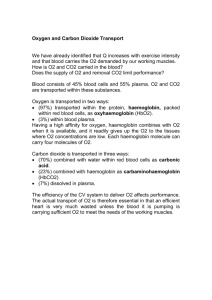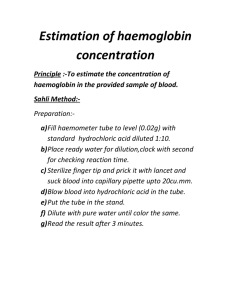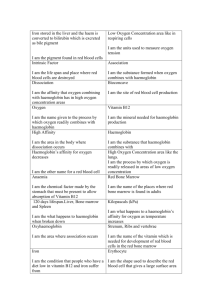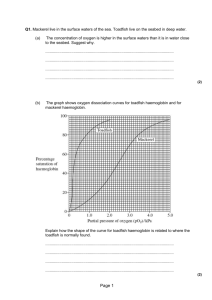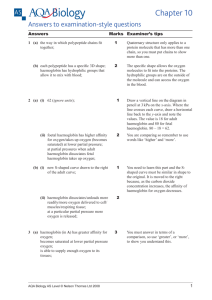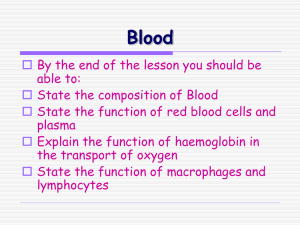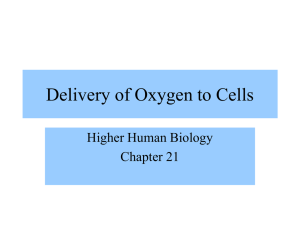Transport of Oxygen and Carbon Dioxide
advertisement
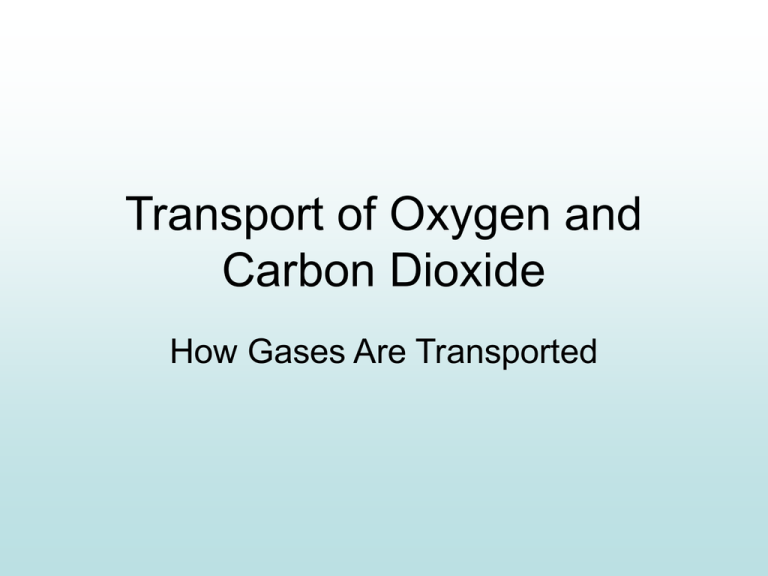
Transport of Oxygen and Carbon Dioxide How Gases Are Transported Introduction Goals For Learning • To explore how O2 is • What you need to transported in the know blood. • Definition of partial • To explore how Co2 is pressure transported in the • Processes of external blood. respiration and • This will include internal respiration. understanding the oxygen dissociation curve. Oxygen Transport • O2 is transported by the blood either, – Combined with haemoglobin (Hb) in the red blood cells (>98%) or, – Dissolved in the blood plasma (<2%). Oxygen Transport • The resting body requires 250ml of O2 per minute. • We have four to six billion haemoglobin containing red blood cells. • The haemoglobin allows nearly 70 times more O2 than dissolved in plasma. Haemoglobin Haemoglobin molecules can transport up to four O2’s When 4 O2’s are bound to haemoglobin, it is 100% saturated, with fewer O2’s it is partially saturated. Co-operative binding: haemoglobin’s affinity for O2 increases as its saturation increases. Oxygen binding occurs in response to the high PO2 in the lungs Lets Now Look at Haemoglobin Saturation • Haemoglobin saturation is the amount of oxygen bound by each molecule of haemoglobin • Each molecule of haemoglobin can carry four molecules of O2. • When oxygen binds to haemoglobin, it forms OXYHAEMOGLOBIN; • Haemoglobin that is not bound to oxygen is referred to as DEOXYHAEMOGLOBIN. Haemoglobin Saturation • The binding of O2 to haemoglobin depends on the PO2 in the blood and the bonding strength, or affinity, between haemoglobin and oxygen. • The graph on the following page shows an oxygen dissociation curve, which reveals the amount of haemoglobin saturation at different PO2 values. The Oxygen Dissociation Curve • Reveals the amount of haemoglobin saturation at different PO2 values. The Oxygen Disassociation Curve Haemoglobin saturation isIn the lungs the partial pressure is approximately determined by the partial pressure 100mm of Hg at this Partial haemoglobin has oxygen. When these values Pressure are a high affinity to 02 and is 98% saturated. graphed they produce the Oxygen Disassociation Curve In the tissues of other organs a typical PO2 is 40 mmHg here haemoglobin has a lower affinity for O2 and releases some but not all of its O2 to the tissues. When haemoglobin leaves the tissues it is still 75% saturated. Haemoglobin Saturation at High Values Lungs at sea level: PO2 of 100mmHg haemoglobin is 98% SATURATED When the PO2 in the lungs declines below typical sea level values, haemoglobin still has a high affinity for O2 and remains almost fully saturated. Lungs at high elevations: PO2 of 80mmHg, haemoglobin 95 % saturated Even though PO2 differs by 20 mmHg there is almost no difference in haemoglobin saturation. Haemoglobin Saturation at Low Values Factors Altering Haemoglobin Saturation Factors Altering Haemoglobin Saturation (Exercise) Factors Affecting Haemoglobin Saturation • Blood acidity… • Blood temperature… • Carbon Dioxide concentration Respiratory Response to Exercise Factors affecting Disassociation BLOOD TEMPERATURE • increased blood temperature • reduces haemoglobin affinity for O2 • hence more O2 is delivered to warmed-up tissue BLOOD Ph • lowering of blood pH (making blood more acidic) • caused by presence of H+ ions from lactic acid or carbonic acid • reduces affinity of Hb for O2 • and more O2 is delivered to acidic sites which are working harder CARBON DIOXIDE CONCENTRATION • the higher CO2 concentration in tissue • the less the affinity of Hb for O2 • so the harder the tissue is working, the more O2 is released Key Point • Increased temperature and hydrogen ion (H+) (pH) concentration in exercising muscle affect the oxygen dissociation curve, allowing more oxygen to be uploaded to supply the active muscles. Carbon Dioxide Transport • Carbon dioxide also relies on the blood fro transportation. Once carbon dioxide is released from the cells, it is carried in the blood primarily in three ways… • Dissolved in plasma, • As bicarbonate ions resulting from the dissociation of carbonic acid, • Bound to haemoglobin. Dissolved Carbon Dioxide • Part of the carbon dioxide released from the tissues is dissolved in plasma. But only a small amount, typically just 7 – 10%, is transported this way. • This dissolved carbon dioxide comes out of solution where the PCO2 is low, such as in the lungs. • There it diffuses out of the capillaries into the alveoli to be exhaled. In Review 1) Oxygen is transported in the blood primarily bound to haemoglobin though a small amount is dissolved in blood plasma. 2) Haemoglobin oxygen saturation decreases. 1) 2) 3) When PO2 decreases. When pH decreases. When temperature increases. In Review Each of these conditions can reflect increased local oxygen demand. They increase oxygen uploading in the needy area. 3) Haemoglobin is usually about 98% saturated with oxygen. This reflects a much higher oxygen content than our body requires, so the blood’s oxygen-carrying capacity seldom limits performance. In Review 4) Carbon dioxide is transported in the blood primarily as bicarbonate ion. This prevents the formation of carbonic acid, which can cause H+ to accumulate, decreasing the pH. Smaller amounts of carbon dioxide are carried either dissolved in the plasma or bound to haemoglobin
